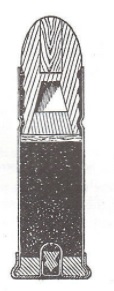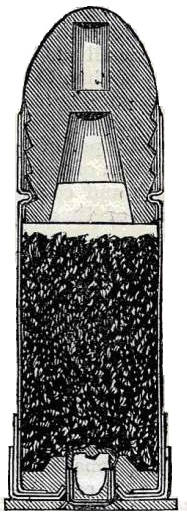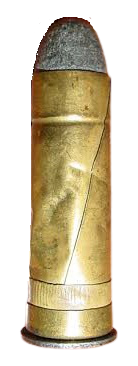The P53 Enfield rifle-musket was adopted by the British Army in 1853 and saw extensive service in the latter stages of the Crimean War (1853-1856). The P53 was a muzzle loading rifle that fired a .577 calibre Minié bullet that expanded on firing to engage with the rifling in the bore. It replaced the earlier short lived Pattern 1851 Minié rifle-musket that suffered both from fouling of the bore and from the .702 calibre ammunition that proved too heavy to allow soldiers to carry the customary 60 cartridges.
However, by the early 1860’s rapid progress was being made in developing self contained metallic cartridges making breech loading rifles a military necessity. In 1864, the War Office decided that the cheapest and quickest way of putting a breech loading rifle into the hands of British soldiers was to convert the existing stock of Enfield rifles. In August 1864, leading gun makers were invited to submit mechanisms to achieve the breech loading conversion. A large number of designs were submitted and after detailed examination, eight designs were short listed. Of these, only four used a self contained cartridge and the rest used separate percussions caps. The firms concerned were each given six Enfield rifles to be converted to breech loading to be returned within 6 months along with 1000 rounds of ammunition.
The conversion provided by the American Jacob Snider was the most promising design but was still found to be unsatisfactory, partly because of the design of the cartridges, but largely because of the way the conversion had been carried out. This involved the removal of about 2.5 inches of the rear of the barrel and then the use of brazing to secure the new breech mechanism which caused concerns that the heat treatment might affect the metallurgic strength of the barrel. This problem was solved by Snider by reverting to the use of a so-called shoe containing the breech mechanism that simply screwed into the tapped end of the barrel. After extensive testing, the Mark I Snider-Enfield rifle was officially approved on 18 September 1866.
Snider-Enfield Rifle Mk I
The Snider conversions were applied to both the long (3-band) and short (2-band) Enfield rifles. Although the long and short Enfield rifle-muskets had barrel lengths of 39 and 33 inches, respectively, this was reduced by 2.5 inches in the Snider conversions due to the length of the shoe. This gave a barrel length of 36.5 inches for the long Snider-Enfield rifle and 30.5 inches for the short rifle. The shoe used in the conversion incorporated a hinged breech block that opened to the right. Once opened, the breech block could be pulled backwards against an internal spring allowing the extractor attached to it to pull the cartridge out of the chamber. By tilting the rifle 90 degrees to the right, this allowed the cartridge to then fall out of the breech.
The breech block incorporated a firing pin that was struck by the standard P53 hammer and was tilted downwards to contact the primer in the centre of the cartridge. The breech block was held in the closed position by a detent pin at the rear of the shoe that engaged in a hole in the rear of the breech block.
The Mk I was originally designed to fire cartridges with rims that had rounded edges. However, with the adoption of square edged cartridge rims, the countersink for the rim in the end of the chamber had to be modified. The modified Snider-Enfield rifles were designated the Mk I*.
Snider-Enfield Rifle Mk II*
The Mk II* Snider rifles (both long and short) were originally converted from the start to take the square edged cartridge rims. The following further modifications were then made to produce the Mk II**:
- the shape and dimensions of the extractor and the form of the shoe slightly altered,
- the underside of the block made of true circular form and to cover completely the head of the cartridge,
- the opening of the shoe made to correspond to the increase in size of the block,
- the nipple slightly shortened
- the hammer cupped out
 Snider-Enfield Rifle Mk III
Snider-Enfield Rifle Mk III
By 1869, the supply of Enfield rifles for conversion was starting to run out. The Mk III was therefore a newly made version of the Snider-Enfield rifle rather than a conversion. It was made using a steel barrel rather than an iron barrel as was the case with the earlier rifles. These rifles are marked with the word STEEL to the left of the back sight.
Unlike the earlier marks of 3-band Snider Rifles that used a 3-groove 1:78 rifling, the Mk III used the rifling employed in the P60 and P61 two-band Enfield rifles; namely, 5 grooves with 1:48 rifling since this had been found to produce the greatest accuracy from the weapons.
It had also been found with the earlier marks that the breech block could blow open under certain circumstances. To remedy this, the Mk III was fitted with a spring loaded catch that operated a bolt in the breech block that engaged with a hole in the back of the shoe. This positively locked the breech block in the closed position.
On the earlier marks, the end of the hammer fitted over the nipple as an extra measure to keeping the breech block closed. Since this was no longer necessary in the Mk III, the end of the hammer was made flat rather than being cupped.
Snider-Enfield Ammunition
The original ammunition provided for the Snider produced very poor shooting accuracy and it was not until Boxer ammunition became available that it could eventually out perform the P53 Enfield rifle-musket.
The cartridge for the Snider-Enfield rifles went through many patterns or marks as the relatively new technology developed. Colonel Edward Mounier Boxer was Superintendent of the Royal Laboratory of the Royal Arsenal at Woolwich during this period and his name is given to both the primer and cartridges used in the Snider-Enfield rifles.
Cartridge Boxer Ball for Snider Rifle Pattern I
The original Pattern I cartridge used a Pottet style folded brass base. Clement Pottet was a Frenchman often credited with the development of the centre fire cartridge which he perfected by 1855. The case consisted of two layers of .003 thick brass foil rolled into a cylinder that was riveted to the brass base via the Boxer cap chamber. The cartridge was covered in thin white paper .
 A round nosed pure lead bullet was used weighing 525 gr which contained a clay plug in the base in a similar way to a Minié bullet . The bullet had four saw tooth cannelures covered in beeswax for lubrication with the brass case crimped into the lower cannelure to secure the bullet. The bullet also incorporated a cylindrical cavity in the nose filled with a wood plug – this was intended to change the moment of inertia of the bullet to improve its stability in flight. However, this resulted in the bullet flattening on impact not unlike later hollow point rounds. The cartridge case contained 70 gr of black powder.
A round nosed pure lead bullet was used weighing 525 gr which contained a clay plug in the base in a similar way to a Minié bullet . The bullet had four saw tooth cannelures covered in beeswax for lubrication with the brass case crimped into the lower cannelure to secure the bullet. The bullet also incorporated a cylindrical cavity in the nose filled with a wood plug – this was intended to change the moment of inertia of the bullet to improve its stability in flight. However, this resulted in the bullet flattening on impact not unlike later hollow point rounds. The cartridge case contained 70 gr of black powder.
Cartridge Boxer Ball for Snider Rifle Pattern II
The Pattern I cartridge did not prove to be serviceable and was only produced in  1866/67. In order to overcome the problems with this cartridge, the Pattern II introduced the type of case used in all subsequent Snider cartridges. It dispensed with the Pottet style rolled brass base and replaced this with a deeper double brass cup riveted to a brass base via the Boxer cap chamber. Again, the cartridge was covered in white paper which was fixed with shellac and India rubber cement. It was filled with 70 gr of black powder covered by a layer of carded wool. This pattern of cartridge was only produced in 1867/68.black powder.
1866/67. In order to overcome the problems with this cartridge, the Pattern II introduced the type of case used in all subsequent Snider cartridges. It dispensed with the Pottet style rolled brass base and replaced this with a deeper double brass cup riveted to a brass base via the Boxer cap chamber. Again, the cartridge was covered in white paper which was fixed with shellac and India rubber cement. It was filled with 70 gr of black powder covered by a layer of carded wool. This pattern of cartridge was only produced in 1867/68.black powder.
Cartridge Boxer Ball for Snider Rifle Pattern III-V
The Pattern III introduced a shorter, lighter bullet weighing 480 gr with just 3 cannelures. It was introduced in 1867 but was short lived.
The Pattern IV was also introduced in 1867 and was similar to the Pattern III except that the brass base disk was changed to an iron one. This change was carried through to all later variants of the cartridge.
The Pattern V simplified manufacture and reduced the amount of overlap between the rolled brass layers. The bullet was 480 gr in weight and reverted to 4 saw toothed cannelures. The cartridge was now covered in brown paper.

The nomenclature was changed from ‘Pattern’ to ‘Mark’ for the Mk VI. In this mark, introduced in 1868, the foil for the cylinder was increased to .005 inch with only a small overlap between the two coils. In addition, the diameter of the bullet was set at .575 inches including the wax layer which produced more accurate shooting.
The Mk VII was introduced in 1869 and was similar to the Mk VI but the bullet was changed to remove the wood plug leaving an empty cavity in the front of the bullet.
The Mk VIII was approved in 1869 and the inside of the case was coated in Shellac and white paper to waterproof it. The other change was to replaced the brass used in the cap chamber by copper.
The Mk IX was approved in 1871 and was similar to the Mk VII but with 3 cannelures instead of 4.
Bayonets
The 3-band Snider rifle was fitted with the Pattern 1853 socket bayonet that effectively clamped against the front sight post using a locking ring. This had a 17 inch triangular blade and was carried in a leather scabbard with brass fittings.

However, the 2-band Snider rifles were fitted with a lug on the right-hand side of the barrel to take the Pattern 1856 Yataghan sword bayonet. This bayonet was originally designed for the P53 Enfield rifle-musket and incorporated a curved blade to provide clearance for use ram rod during loading of the P53. Using the Yataghan bayonet, the reach of the 2-band Snider was then the same as the 3-band rifle with the socket bayonet fitted.

The Snider-Enfield Artillery Carbine
The Artillery carbine was two-band with a barrel length of 21.25 inches. It was intended to be used for defence for artillery units and was 9 inches shorter than the 2-band short rifle.

The Snider-Enfield Cavalry Carbine
The cavalry carbine was half-stocked with one barrel band and had a barrel length of only 19.5 inches.
 My Snider-Enfield Rifle Mk II**
My Snider-Enfield Rifle Mk II**
My Snider-Enfield long rifle is marked Tower 1871 but does not contain a mark number. It is certainly not a Mk III and is therefore assumed to be a Mk II**. It is fitted with the Pattern 1853 socket bayonet, the same as fitted to the Pattern 1853 Enfield rifle-musket.

Snider-Enfield Rifle Specifications
- Weight: 9 lb 10 oz (3-band long rifle)
- Weight of Bayonet: 11 oz
- Length of Rifle: 4 ft 7 in
- Length with Bayonet: 5 ft 11 in
- Length of Barrel: 36.5 in
- Calibre: .577 in
- Cartridge: Boxer self-contained metallic cartridge
- Bullet: 480 gr lead
- Muzzle Velocity: 1250 fps
- Front Sight: Barleycorn
- Rear Sight Bed: To 400 yds in 100 yd steps
- Rear Sight Leaf: To 800 yds
- Rifling: Three grooves
- Rifling Twist: Right-handed with 1 turn in 78 in
![]()

